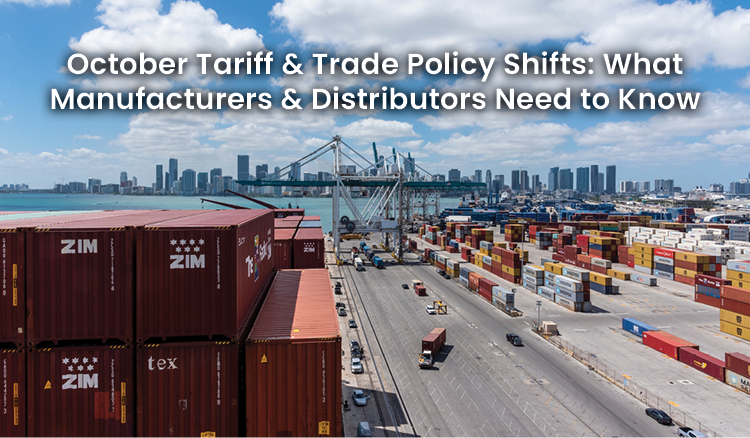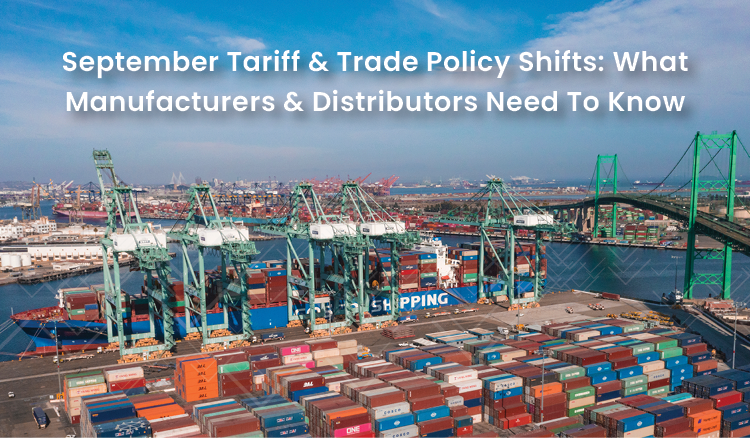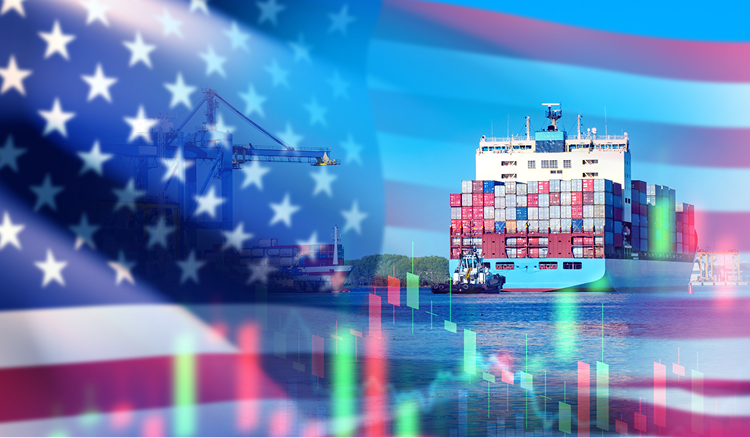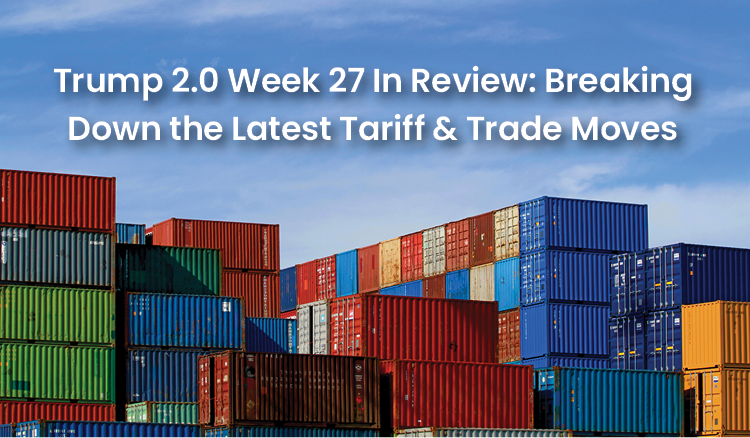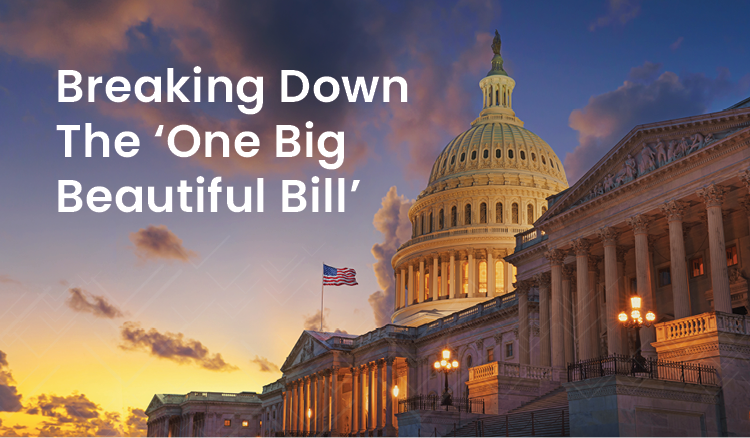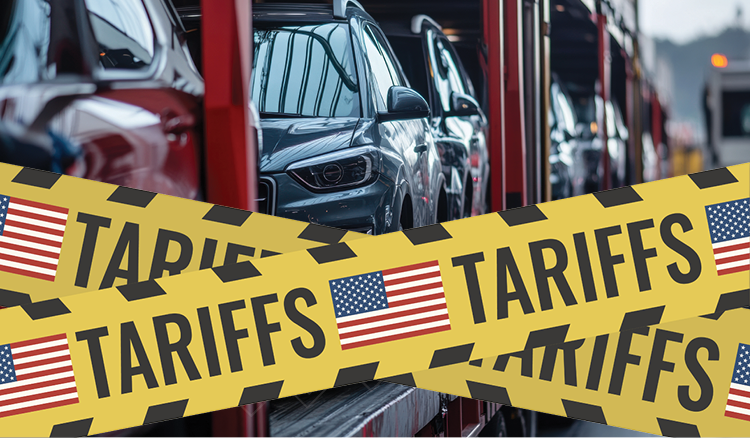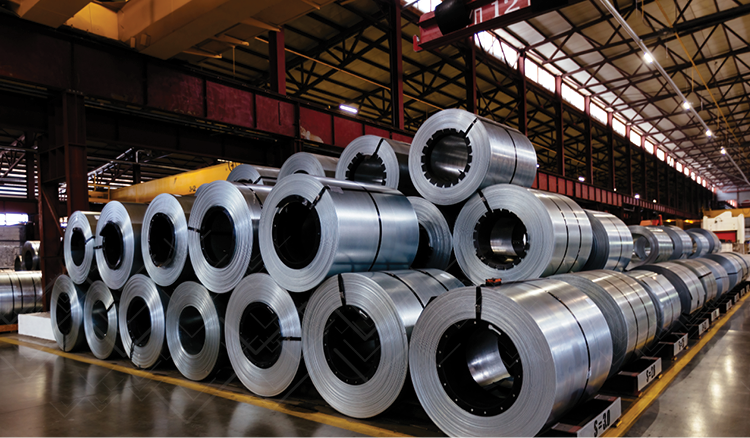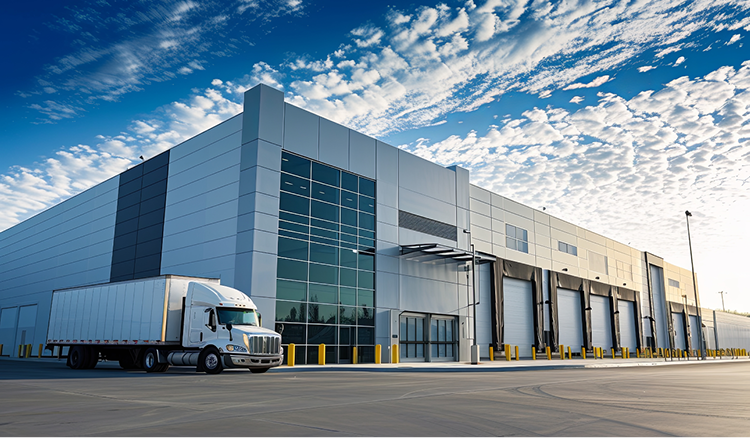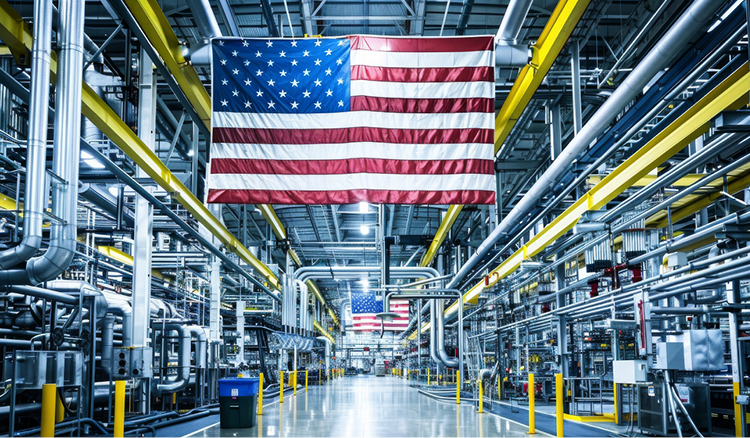Navigating Trump 2.0
Veryable is your trusted source for information and insights as you navigate the upcoming policy changes and regulatory shifts driving a U.S. Manufacturing Renaissance under the new administration.
What's Ahead For U.S. Manufacturers and Distributors?
With Donald Trump now back in the White House and the Republican Party holding a narrow majority in both the Senate and House, a new wave of policy shifts is already underway—many of which will directly impact the manufacturing and distribution landscape.
As former operations leaders, we understand that your time is limited and your focus is on running your business—not tracking every political development. That’s why we’ve created this hub to keep you informed, without the noise.
Below, you’ll find a breakdown of key policy updates, insights into what may be on the horizon, and how these changes could affect your operations. We’ve also launched a new podcast and published a series of blog articles to help you stay ahead and position your business for success in this evolving environment.
Reinstitution and Expansion of Tariffs
Tariffs
Reinstitution and Expansion of Tariffs
Since taking office for his 2nd term, President Trump has rapidly reasserted tariffs as a core instrument of U.S. trade policy. In just over five months, the administration has rolled out and threatened a sweeping series of tariffs aimed at reducing trade imbalances, reshoring manufacturing, and forcing foreign governments to negotiate under new terms favorable to American interests.
For a full list of country-specific tariffs, click here.
For a full list of product-specific tariffs, click here.
Key Objectives:
1. Reduce the U.S. trade deficit
2. Realign global supply chains away from China and BRICS-aligned nations
3. Use tariff leverage to accelerate bilateral trade deals
4. Incentivize domestic production in critical sectors such as steel & aluminum, energy, pharmaceuticals, and semiconductors
This Week's Developments (as of November 25th, 2025):
-->November 20th:
1.) The U.S. Department of Commerce announced it will delay formal implementation guidance for the truck-tariff deferral carve-out modelling until mid-Q1 2026, giving fleets and OEMs more time to prepare for the 25% heavy-truck duty.
2.) The Office of the U.S. Trade Representative (USTR) published a notice inviting public comment on proposed updates to rules of origin for the new U.S.–Switzerland trade framework, including how much Swiss investment in U.S. manufacturing qualifies for preferential treatment. (See USTR press portal)
-->November 19th:
1.) The U.S. Department of Agriculture said it is “crunching numbers” to evaluate potential tariff relief for certain agricultural products after the November 14th executive-order modifications, taking into account changes during the government shutdown.
2.) The White House released a fact sheet confirming that the bilateral frameworks with Argentina, Ecuador, Guatemala and El Salvador will proceed on a rolling basis – certain tariff relief will begin before full treaty text is negotiated. (White House fact sheet)
-->November 14th:
1.) The U.S. and Switzerland reached a framework trade deal under which U.S. tariffs on Swiss exports will be lowered to ~15% from ~39%. Switzerland will shift some production (pharma, gold smelting, rail equipment) to the U.S. as part of the deal.
2.) The U.S. and Switzerland reached a framework trade deal under which U.S. tariffs on Swiss exports will be lowered to ~15% from ~39%. Switzerland will shift some production (pharma, gold smelting, rail equipment) to the U.S. as part of the deal.
-->November 13th:
1.) The U.S. signaled that under the new Latin America trade frameworks, tariffs will remain for most goods (10% or 15%) but will be removed or reduced for goods the U.S. cannot produce domestically (ex: coffee, bananas)
2.) The U.S. internal communications indicated that tariff exclusion lists will be published shortly to address high consumer-price items (e.g., food items) as part of the White House’s broader low-inflation / tariff-relief initiative.
-->November 12th:
1.) Vietnam’s Deputy Prime Minister announced that Hanoi is in Washington negotiating a trade deal with the United States, aiming to finalise an agreement within weeks that would maintain a U.S. tariff baseline of ~20% on Vietnamese imports while carving out exemptions for key goods.
2.) Scott Bessent, U.S. Treasury Secretary, said “substantial moves” are coming to reduce U.S. consumer prices on goods such as coffee, bananas and other imports — though he did not specify exact tariff cuts or mechanisms.
-->November 11th:
1.) Switzerland could reach a deal with the United States to lower U.S. tariffs on Swiss goods to 15%, potentially as soon as the end of the week, following productive talks between Swiss and U.S. officials.
2.) The Supreme Court of the United States began public hearings on the legality of the U.S. tariffs under the International Emergency Economic Powers Act (IEEPA), raising questions on the executive role in taxing imports.
-->November 10th:
China’s transport ministry suspended select port and navigation fees on U.S.-linked vessels for one year, aligning with the U.S.–China de-escalation steps tied to the recent Busan talks.
-->November 9th:
1.) USTR opened a formal comment docket to suspend—for one year starting Nov 10—Section 301 maritime-related actions tied to China (e.g., port fees/crane measures), as part of the implementation mechanics of the U.S.–China understanding.
2. China suspends ban on exports of gallium, germanium, and antimony to the U.S., effective through Nov 27, 2026.
What Business Leaders Should Do Now
With tariffs back on the table and trade tensions escalating, manufacturers, importers, and distributors face a renewed wave of uncertainty.
To stay competitive, leaders should take a proactive approach:
1. Map and Monitor Tariff Exposure
2. Diversify Your Supply Base
3. Accelerate Reshoring Plans
4. Stay Agile with On-Demand Labor
5. Stay Ahead of Policy Shifts
Trade Agreements & Supply Chain Realignment
Trade Policy
Trade Agreements & Supply Chain Realignment
The second Trump administration continues to prioritize reshoring U.S. manufacturing, protecting domestic supply chains, and countering foreign dependencies. Since late summer, that agenda has accelerated — with selective tariff deployment, revised trade frameworks, conditional enforcement pauses, and reciprocal dealmaking reshaping global trade relationships.
Confirmed Developments (As of November 5th, 2025)
U.S.–Japan Trade Pact Finalized
→ Entered into force mid-September. The deal lowered tariffs on Japanese autos, auto parts, and select consumer goods to 15%, while Japan expanded purchases of U.S. beef, pork, corn, and LNG.
→ For U.S. manufacturers and distributors, this ensures stable access to Japanese components while deepening demand for American agriculture and energy exports.
U.S.–EU Framework Agreement (Activated September 18)
→ The U.S. and EU locked in a 15% tariff ceiling on EU goods entering the U.S.
→ Pharmaceuticals were included under the ceiling, but generics received explicit exemptions.
→ The EU pledged $600 B in U.S. investment and $750 B in energy purchases by 2027.
→ Germany is seeking targeted steel quota relief following implementation.
U.S.–South Korea Framework (Active August 2025)
→ South Korean exports to the U.S. face a 15% tariff (down from 25%), while U.S. exports remain duty-free.
→ Seoul committed $350 B in U.S. investments and $100 B in LNG purchases.
→ U.S. agricultural and automotive exports continue to benefit from tariff-free access, while Korea maintains protections on rice and beef.
New Bilateral Engagements: India, Indonesia & Philippines
→ The U.S. and India resumed high-level trade talks focused on manufacturing, energy, and defense cooperation. On Nov 12, India approved a ₹450.6 billion (~$5.1 billion) export-support package to offset recent U.S. tariffs (some as high as 50%) on textiles, jewelry, and chemicals. Relief discussions continue, with partial tariff alignment expected by year-end.
→ Indonesia continues phasing in tariff eliminations for most U.S. agricultural and industrial imports under its July commitments.
→ The Philippines’ tariff-free regime on U.S. goods remains in force; reciprocal 19% tariffs on Philippine exports remain under 2026 review.
U.S.–U.K. Bilateral Trade Agreement (Implemented May 2025)
→ Tariffs on U.K. steel and aluminum eliminated; auto tariffs reduced to 10% for the first 100,000 vehicles annually.
→ In exchange, the U.K. granted expanded access for U.S. ethanol, beef, and industrial exports.
U.S. - Vietnam Trade Framework (In Negotiation)
-->As of Nov 12, Vietnam confirmed active negotiations with Washington to formalize a trade framework that would set a ~20% tariff baseline on Vietnamese imports while carving out exemptions for high-value categories such as apparel, footwear, and electronics.
--> The agreement would solidify Vietnam’s role as a “China + 1” production hub and offer U.S. buyers a moderate-tariff sourcing alternative.
U.S. - Switzerland Trade Framework (Announced November 14th)
--> The U.S. and Switzerland reached a framework deal lowering tariffs on Swiss exports to ~15% from ~39%.
--> Switzerland will shift portions of its pharmaceutical, rail-equipment, and gold-smelting production to the U.S. to qualify for preferential access.
--> This represents one of the administration’s first bilateral agreements tying tariff relief directly to relocation of manufacturing capacity to the U.S.
U.S. - Latin America Trade Frameworks (Argentina, Ecuador, Guatemala, El Salvador — Signed Nov 14)
--> Latin America Trade Frameworks (Argentina, Ecuador, Guatemala, El Salvador — Signed Nov 14)
--> The U.S. announced four new trade framework agreements removing or reducing tariffs on selected goods such as coffee, bananas, and pharmaceutical inputs.
--> The agreements expand market access for U.S. exporters while lowering consumer-price pressure on imports that the U.S. does not produce domestically.
Section 232 Investigations & Tariff Expansion
→ The U.S. Commerce Department launched new Section 232 probes into medical equipment, robotics, and industrial machinery (Sept 24).
→ Tariffs of 10% on lumber and 25% on kitchen cabinets and upholstered wood goods took effect Oct 14. Scheduled step-ups into 2026 remain active.
→ The EU tightened steel import quotas and raised tariffs to 50% on shipments exceeding those limits.
->A 25% tariff on medium + heavy duty trucks took effect Nov 1, along with 10% on imported buses.
U.S. Expands Export Blacklist (Effective Sept 29)
→ Any subsidiary 50% or more owned by a blacklisted entity now inherits the same export restrictions, closing prior loopholes. This change raises compliance risks for multinationals with global affiliates and complex ownership structures.
NEW — U.S. - China Truce (Late October)
-> U.S. tariff rates on Chinese imports were reduced modestly (to ~47% from ~57%) for a one-year term — conditional and reversible at the tariff-line (HS code) level.
-> China paused new rare-earth export controls for the same duration and pledged increased purchases of U.S. soybeans and energy products.
-> Verification standards, compliance checkpoints, and HS-level tables are still being finalized; reductions may snap back automatically if purchase benchmarks are missed.
Immigration
Immigration
Immigration Reform
Since January 2025, the Trump administration has taken a more aggressive stance on immigration enforcement and border control, framing these actions as essential to national security and domestic labor protection. Over the past few months, these policies have expanded beyond the southern border to affect visa processing, work authorization, driver credential verification, and workforce compliance. For manufacturing, warehousing, logistics, and transportation companies, immigration is no longer a border-only issue. It is now a daily operational variable inside the domestic supply chain.
Below are the verified developments and their implications for manufacturing and logistics operations.
Confirmed Developments (As of November 5th, 2025)
ICE Enforcement Surge & Detention Expansion
→ ICE arrests remain elevated, up roughly 250–270% year-over-year, with operations increasingly targeting undocumented individuals without criminal records.
→ Detention centers continue to operate above capacity, prompting new federal contracts and construction plans — DHS internal planning is now targeting ~110,000 detention beds by early 2026.
→ Recent internal DHS guidance directs regional ICE offices to coordinate with local law enforcement on “integrated enforcement zones” near industrial hubs and logistics corridors, not just major border entry points.
Deportation Flights & Border Operations
→ DHS has now conducted more than 800 deportation flights since January 2025, with expanded use of commercial charter carriers to supplement military aircraft.
→ Weekly removal operations have increased sharply since late August, with DHS reporting nearly 310,000 deportations to date — on pace to potentially exceed 400,000 by year-end.
→ The administration reaffirmed its target of 1 million deportations annually, though analysts note that logistical constraints and court challenges may pose practical friction to reaching that goal.
Executive Order 14159: “Protecting the American People Against Invasion”
→ Re-issued under emergency authority, this order continues to enable expedited removals, limits asylum eligibility, and increases ICE and CBP deployments across border states.
→ The order also restricts access to certain federal benefits for undocumented individuals and expands cross-agency data sharing to locate those with expired visas.
Visa & Immigration Enforcement Changes
→ DHS has fully implemented its “Catch-and-Revoke” system for visa compliance, allowing automatic suspension of student, work, and visitor visas upon detected status violations.
→ Enhanced vetting now includes mandatory social media screening and expanded background reviews for both new and renewing visa applicants.
→ New data-sharing agreements between DHS, the Department of Labor, and the Social Security Administration are producing an uptick in I-9 audits and E-Verify enforcement across industries.
→ The Department of Labor has announced plans to tie future work-visa allocations to demonstrated domestic recruitment efforts — a potential headwind for manufacturers and logistics firms reliant on H-2B or similar programs.
Implications for Manufacturing & Logistics Operations
→ Labor availability is tightening: Heightened enforcement and deportations are shrinking the available pool of undocumented and temporary workers, especially in warehousing, food processing, and logistics.
→ Compliance exposure is growing: I-9 audits and E-Verify inspections are becoming more frequent, particularly for employers with large hourly workforces or high turnover.
→ Wage pressures are rising: Reduced access to flexible labor is driving increased overtime and reliance on temp agencies, inflating operating costs and eroding productivity.
→ Regional disparities are emerging: Facilities near enforcement zones face higher labor volatility, making agile staffing strategies a key differentiator.
Incentives For Domestic Manufacturing
Incentives
Incentives For Domestic Manufacturing
The One Big Beautiful Bill Act (H.R. 1) delivers the most significant federal push in decades to bring manufacturing and logistics production back to U.S. soil. It offers powerful tax incentives designed to accelerate facility upgrades, modernization, and domestic supply-chain expansion.
What’s New:
Permanent R&D Expensing
Beginning in tax year 2025, domestic R&D expenditures may be fully deducted in the year incurred—eliminating the five-year amortization requirement. Small businesses can even apply this deduction retroactively to R&D expenses incurred after 2021.
100% Bonus Depreciation + QPP Expensing
-->Section 168(k): Restores 100% bonus depreciation for tangible property (machinery, equipment, and tools) acquired after January 19, 2025
-->Section 168(n): Creates full expensing for Qualified Production Property (QPP)—covering new factories or qualified improvements to production-related real property.
EBITDA-Based Interest Deductibility
The bill permanently restores the pre‑2022 standard for the business interest deduction—allowing interest on loans and leases to be deducted based on EBITDA rather than EBIT, increasing borrowing capacity for capital-intensive projects
Why This Matters for Domestic Manufacturers
These provisions create a clear financial advantage for U.S. operations:
-->Immediate cost recovery on factory upgrades, automation, and facility investments—accelerating ROI and preserving capital.
-->Enhanced support for innovation by allowing immediate write-off of R&D investments.
-->Greater financing flexibility for capital-intensive expansion through improved interest deduction rules.
Whether you're modernizing a plant, expanding warehousing, or rebuilding supply chains—this legislation aligns the tax code with on-the-ground manufacturing growth.
How Veryable Helps You Respond Faster
While these incentives unlock powerful tax advantages, success still depends on your ability to scale operations quickly and efficiently.
That’s where Veryable comes in. Our on-demand labor model gives manufacturers and distributors the flexibility to:
-->Stand up new lines or facilities rapidly without long hiring cycles,
-->Handle demand surges tied to contracts, seasonal peaks, or reshoring wins,
-->Expand into new marketswith a lean, variable labor cost structure.
The bottom line: Veryable helps you turn federal incentives into real-world output—without adding long-term headcount or fixed cost.
Tax Policy Reforms
Tax Reform
Tax Policy Reforms
On July 4, 2025, President Trump signed the H.R.1 – One Big Beautiful Bill Act into law, representing the most sweeping business tax reform since the Tax Cuts and Jobs Act (TCJA) of 2017. The bill makes several TCJA provisions permanent and introduces targeted incentives aimed at accelerating investment in the U.S. manufacturing, warehousing, and logistics sectors.
This legislation signals a strong federal commitment to reshoring industrial capacity, modernizing facilities, and incentivizing innovation through the tax code.
Key Provisions of the H.R.1 – One Big Beautiful Bill Act:
Permanent Full Expensing for Capital Investment
100% bonus depreciation is restored and made permanent for short-lived capital assets (under 20 years), including machinery, tools, and equipment.
The bill adds a new provision under §168(n) allowing full expensing of Qualified Production Property (QPP) such as:
-->New manufacturing or logistics facilities
-->Upgrades to existing warehouses or production lines
-->Major capital improvements
Construction must begin before December 31, 2028, and assets must be placed in service before January 1, 2031.
Immediate R&D Expensing
The bill permanently restores the immediate deduction of R&D expenses, reversing the TCJA’s five-year amortization rule that took effect in 2022.📉
EBITDA-Based Interest Deductibility
-Reverts interest deduction limits back to an EBITDA basis (instead of EBIT), increasing financing flexibility—especially important for capital-intensive industries like manufacturing and logistics.
Corporate and Pass-Through Tax Clarity
The 21% corporate tax rate is retained permanently. While the bill does not raise the pass-through deduction, it extends the TCJA §199A deduction for pass-through businesses (like LLCs and S Corps) beyond its original sunset date of 2025.
International Tax Reform
The bill preserves and modifies key international tax rules including:
-FDII (Foreign-Derived Intangible Income)
-GILTI (Global Intangible Low-Taxed Income)
-BEAT (Base Erosion and Anti-Abuse Tax)These are adjusted to encourage onshoring of intellectual property and discourage profit shifting.
Estate Tax Exemption
The doubled estate tax exemption from the TCJA (approx. $13M per individual) is made permanent, protecting many family-owned manufacturers from estate tax exposure.
Implications for U.S. Manufacturing, Warehousing, and Logistics
-Major incentive to reshore operations and modernize domestic production
-Supports facility expansion, automation, and advanced manufacturing adoption
-Encourages contract manufacturing, especially for reshoring or nearshoring initiatives
-Improves financing options for asset-heavy operations via EBITDA treatmentMakes tax planning more predictable, encouraging longer-term investments
Bottom Line: This bill rewards U.S.-based investment. Companies that can scale efficiently, move quickly, and stay agile will be in the strongest position to win contracts, grow margins, and future-proof operations.
Regulatory Reforms
Regulatory Reforms
Regulatory Reforms
Following the signing of the One Big Beautiful Bill Act (H.R.1) and President Trump’s return to office, the administration has taken a more business-friendly regulatory stance—particularly in the areas of labor classificationand energy policy. While many deregulatory efforts are still unfolding, a few early moves are already impacting U.S. manufacturers and distributors.
Key Regulatory Developments
Labor Classification: DOL Halts Enforcement of Independent Contractor Rule
In May 2025, the U.S. Department of Labor formally announced it will not enforce the 2024 rule that tightened standards for classifying independent contractors under the Fair Labor Standards Act (FLSA).
-->This means employers face less risk of federal enforcement when using 1099 workers.
-->However, the 2024 rule remains in effect and can still be enforced through private litigation or state action.
Corporate Reporting: ESG and Transparency Rules Paused or Withdrawn
The administration has paused or withdrawn several proposed federal disclosure rules, including:
-->A climate-related financial disclosure mandate for federal contractors. These delays lower anticipated administrative burden but do not repeal existing laws, such as those under the Corporate Transparency Act (CTA).
Energy Policy: Signals of Deregulation
While H.R.1 does not contain direct environmental or permitting reforms, the administration has publicly signaled intentions to:
-->Repeal the EPA’s 2009 greenhouse gas endangerment finding—a foundational regulation underpinning many climate rules.
-->Review emissions standards for vehicles and industrial sources.
No final rulings have been published, but energy-intensive sectors (e.g., refining, mining, heavy manufacturing) are anticipating possible regulatory relief.
Implications for Manufacturers and Distributors
-->Increased labor flexibility from the DOL enforcement pause allows companies to use independent contractors more confidently to scale operations or meet temporary demand.
-->Reduced compliance risk around ESG reporting enables small and mid-sized manufacturers to allocate more resources to growth rather than administrative tracking.
-->Pending energy policy changes may lower operating costs over time, but businesses should continue monitoring regulatory developments closely.
How Veryable Helps You Stay Ahead
Even as the regulatory picture evolves, operational agility remains the advantage. With Veryable’s on-demand labor model manufacturers and distributors can:
-->Tap into a growing pool of skilled workers—while aligning with the DOL’s latest enforcement posture.
-->Adjust headcount quickly for production surges, facility expansions, or seasonal peaks—without the friction of long hiring cycles.
-->Stay lean, scalable, and focused on growth, even amid uncertain regulatory or market conditions.
Whether you’re navigating changing labor rules or positioning for tax-advantaged expansion, Veryable helps you execute with speed and confidence.
When The Only Certainty is Uncertainty, Agility Is Crucial For Success
While the full scope of President Trump’s second-term agenda is still unfolding, early policy moves already signal significant shifts in the U.S. economic and regulatory landscape. These developments will bring both new opportunities and operational challenges—and the businesses that succeed will be the ones that stay agile and adaptable.
Partnering with Veryable gives you more than just agility—it connects you with experienced operational strategists and a proven approach to navigating uncertainty. Our platform empowers you to quickly scale your workforce in response to market changes, reduce fixed labor costs, and seize growth opportunities with confidence and speed.
Explore our latest blog articles at the bottom of the page to learn how Veryable can help your business not only adapt but thrive in this evolving environment.
U.S. Manufacturing Today Podcast
Hosted by Veryable’s Head of Reindustrialization & Growth Innovation, Matt Horine, this podcast is your go-to source for clear, actionable insights in a time of sweeping policy change. In each episode, we cut through the noise of sensational headlines and conflicting narratives to deliver grounded analysis on what these once-in-a-generation shifts mean for your business.
You’ll also hear firsthand from operations professionals, business leaders, and industry experts as they share how they’re adapting to today’s evolving economic landscape—so you can do the same with confidence and clarity.
We'll be releasing new episodes each Tuesday at 6AM CST. To ensure you don't miss out, make sure to subscribe on: Apple Podcasts, Pocket Casts, Spotify, or YouTube.
Thought Leadership Blog
Gain valuable insights related to upcoming changes under the new administration
October Tariff & Trade Policy Recap: Delayed Pharma Tariffs, Truck Duties Finalized, and New Enforcement Pressures
Trump 2.0 September Tariff & Trade Recap: Discussing New Tariffs, Plus The Latest Trade Deals and Court Rulings
A New Normal for Houston Manufacturers & Distributors: Thriving Under Trump 2.0
Trump 2.0 Week 30 In Review: Discussing The China Deadline Extension, The Potential For Even Higher Tariffs on India, and More
Trump 2.0 Week 29 In Review: Discussing The Impending Tariffs on Semiconductors and Pharmaceuticals, Escalating Tensions With India, and More
Trump 2.0 Week 28 In Review: Discussing The New Country-Specific Rates, The New Tariffs on Copper & Transshipped Goods, and More
Trump 2.0 Week 27 In Review: New Trade Deals with Japan & Indonesia, Stalled Talks with Canada & India, and Tense Negotiations with the EU
Breaking Down The ‘One Big Beautiful Bill’ and What It Means For Manufacturers and Distributors
How Veryable Addresses The Top 5 Challenges Highlighted in the NAM's Q2 2025 Survey
Hidden Inefficiencies in American Manufacturing and How It Impacts Capacity & Consumer Prices
Trump’s New Tariff on Imported Vehicles: Details, Implications, and How Veryable Can Help
The Reshoring Reckoning: Why American Manufacturing Can’t Afford to Wait This One Out
Section 232 Tariffs: What They Are, Implications for Manufacturers & Distributors, & How Veryable Can Help
The Pressure That Creates Progress: Why Those Who Move First Win the Most
Labor Arbitrage is for Losers
Trump, Immigration, & U.S. Manufacturing - What You Need To Know & How Veryable Can Help
Unlocking New Revenue Streams: How 3PLs Can Transform Supply Chains with On-Demand Labor
Agility Drives Profitability: How Veryable Enables Rapid Business Pivots
What The New Administration Means For The U.S. Manufacturing Sector
The Tide is Turning: How Upcoming Regulatory Shifts Will Boost the Gig Economy and the 1099 Workforce
Looking For Specific Guidance?
Amidst policy changes, uncertainty is inevitable. If you need further guidance or have any questions on any of these topics, we've got you covered - our team has over a century of combined experience in the manufacturing and distribution sectors.






